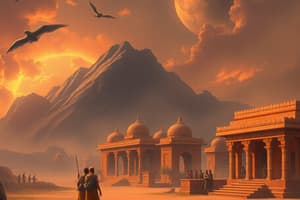Podcast
Questions and Answers
What is a notable feature of Harappan cities?
What is a notable feature of Harappan cities?
- Elaborate storage facilities (correct)
- Grand temples
- Imposing palaces
- Elaborate marketplaces
What was a primary source of livelihood for the Harappan people?
What was a primary source of livelihood for the Harappan people?
- Fishing
- Agriculture and animal farming (correct)
- Hunting
- Mining
What was the purpose of the Great Bath in Mohenjodaro?
What was the purpose of the Great Bath in Mohenjodaro?
- A storage facility
- A royal palace
- A public bathing area (correct)
- A temple for worship
What was used for financing in the Harappan Civilization?
What was used for financing in the Harappan Civilization?
What is a notable artifact found in Harappan workshops?
What is a notable artifact found in Harappan workshops?
What is a unique feature of the Harappan people's relation to animals?
What is a unique feature of the Harappan people's relation to animals?
What was a unique feature of the sewage system in Harappan cities?
What was a unique feature of the sewage system in Harappan cities?
What can be inferred about the Indus Valley script?
What can be inferred about the Indus Valley script?
What was the purpose of the citadel in Harappan cities?
What was the purpose of the citadel in Harappan cities?
How were the houses built in Harappan cities?
How were the houses built in Harappan cities?
What is a notable feature of Harappan architecture?
What is a notable feature of Harappan architecture?
What can be said about the economy of the Harappan Civilization?
What can be said about the economy of the Harappan Civilization?
Flashcards are hidden until you start studying
Study Notes
Harappan Civilization: A Comprehensive Overview
The Harappan Civilization, also known as the Indus Valley Civilization, flourished from approximately 3300 to 1300 BCE in the regions surrounding the Indus River. This ancient civilization is known for its urban planning, writing system, religion and beliefs, trade and economy, and art and craft. In this article, we will delve into these subtopics to provide a comprehensive understanding of the Harappan Civilization.
Urban Planning
Harappan cities were divided into two or more parts. The western part was smaller but higher, known as the citadel, which housed granaries, places of worship, public spaces, and assembly halls. The lower town, located to the east, was relatively larger but lower, and was divided into rectangular sections of wide roads perpendicular to each other. People built single or multiple houses on each side of the road, with rooms built around the veranda. The towns had well-planned sewage systems, with each house having a drain linked to the street drains, which were further connected to larger drains. The drains were also covered with stone blocks laid in neat lines along with inspection holes for cleaning purposes.
Writing System
The Indus Valley script, used by the Harappans, has not been deciphered, with around 400 different symbols identified inscribed in objects. These symbols appear in strings of between 3 and 20 and are believed to be names, as they do not have any other meaning.
Religion and Beliefs
Despite having an organized way of life, there is no depiction or evidence of any ruler or any governing system for the Harappan civilization. The closest depiction to any kind of central figure is a terracotta sculpture believed to be that of a priest-king. There is no evidence of warfare from the Indus Valley Civilization, indicating that they were generally a peace-loving people.
Trade and Economy
The Harappan Civilization's economy was centered on animal farming and agriculture, with wheat, barley, pulses, and other plants grown. They made a living by making ceramics, weaving, and hunting. Financing was done with metals like gold, silver, and copper. Domesticated animals such as goats, cows, and sheep were prevalent. The people of the Indus Valley Civilization relied extensively on both types of cattle. The Indus farmers' carts and ploughs were drawn by oxen, while cows produced milk. The most prevalent animals employed were oxen.
Art and Craft
Harappan cities had elaborate storage facilities, and special structures were constructed on the citadel. For instance, in Mohenjodaro, a very special tank, called the Great Bath, was built in this area. Some towns like Mohenjodaro, Harappa, and Lothal had elaborate storage facilities. Workshop for making beads: stone pieces, half beads, tools for making beads, and finished beads have also been discovered.
In conclusion, the Harappan Civilization was a remarkable civilization that left an indelible mark on history through its urban planning, writing system, religion and beliefs, trade and economy, and art and craft. Though the reasons for its decline are still a matter of debate, it is undeniable that the Harappan Civilization played a significant role in shaping the future of human civilization.
Studying That Suits You
Use AI to generate personalized quizzes and flashcards to suit your learning preferences.




